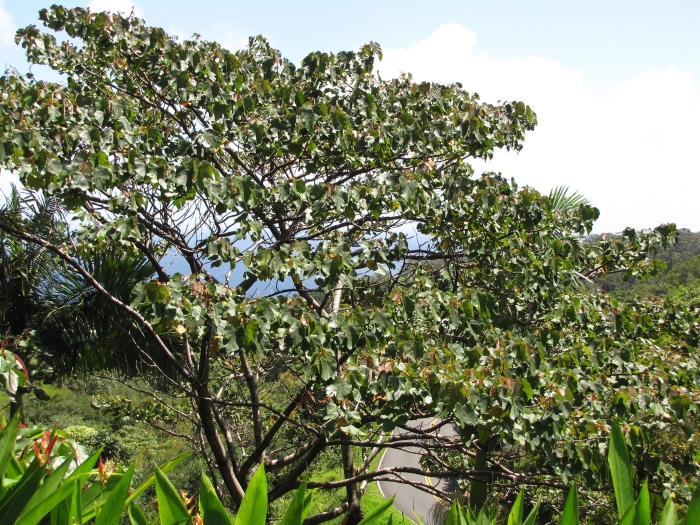Balsa Tree
(Ochroma pyramidale)
Balsa Tree (Ochroma pyramidale)
/
/

Forest and Kim Starr
CC BY 2.0
Image By:
Forest and Kim Starr
Recorded By:
Copyright:
CC BY 2.0
Copyright Notice:
Photo by: Forest and Kim Starr | License Type: CC BY 2.0 | License URL: https://creativecommons.org/licenses/by/2.0/ | Uploader: Starr Environmental | Publisher: Flickr |

























Estimated Native Range
Summary
Ochroma pyramidale, commonly known as Balsa Tree, is a deciduous tree native to tropical rainforests in Central America, the Caribbean, and South America. It is renowned for its rapid growth rate and can reach heights of up to 30 meters. Despite being classified as a hardwood, balsa wood is exceptionally soft and lightweight, with a lower density than cork, which makes it the softest commercial hardwood. Balsa trees have a relatively short lifespan, typically not exceeding 30 to 40 years. The large, showy flowers are a distinctive feature, blooming from the third year onward, usually at the end of the rainy season when few other trees are in flower. These flowers, which open in the late spring afternoons and remain open overnight, can contain a deep pool of nectar up to 2.5 cm. The tree’s foliage is evergreen or dry-season deciduous, with large 30- to 40-cm, weakly palmately lobed leaves.
The Balsa Tree is valued for its lightweight wood, which is used in model making, insulation, and as a core material in the composite industry. Its rapid growth and soft wood make it a sustainable resource for timber production. In cultivation, it thrives in full sun and requires medium amounts of water, preferring soils with slow drainage. While not commonly used in ornamental horticulture, it can be an interesting specimen in large tropical or subtropical gardens. Gardeners should be aware that the Balsa Tree may require regular pruning to manage its size and shape.CC BY-SA 4.0
The Balsa Tree is valued for its lightweight wood, which is used in model making, insulation, and as a core material in the composite industry. Its rapid growth and soft wood make it a sustainable resource for timber production. In cultivation, it thrives in full sun and requires medium amounts of water, preferring soils with slow drainage. While not commonly used in ornamental horticulture, it can be an interesting specimen in large tropical or subtropical gardens. Gardeners should be aware that the Balsa Tree may require regular pruning to manage its size and shape.CC BY-SA 4.0
Plant Description
- Plant Type: Tree
- Height: 30-60 feet
- Width: 10-20 feet
- Growth Rate: Rapid
- Flower Color: Yellow
- Flowering Season: Spring
- Leaf Retention: Deciduous
Growth Requirements
- Sun: Full Sun
- Water: Medium
- Drainage: Slow
Common Uses
Bird Garden, Drought Tolerant, Low Maintenance
Natural Habitat
native to tropical rainforests in Central America, the Caribbean, and South America
Other Names
Common Names: Balsa Wood, West Indian Balsa, Balsa, Bois Flot, Algodoeiro, Algodão Bravo, Pau De Balsa, Balsaholz, Bois Flo, Bois Madame
Scientific Names: , Ochroma pyramidale, Ochroma lagopus, Ochroma bicolor, Ochroma obtusa, Ochroma tomentosa, Ochroma grandiflora, Ochroma boliviana, Ochroma limonense, Ochroma lagopus var. occigranatensis
GBIF Accepted Name: Ochroma pyramidale (Cav.) Urb.